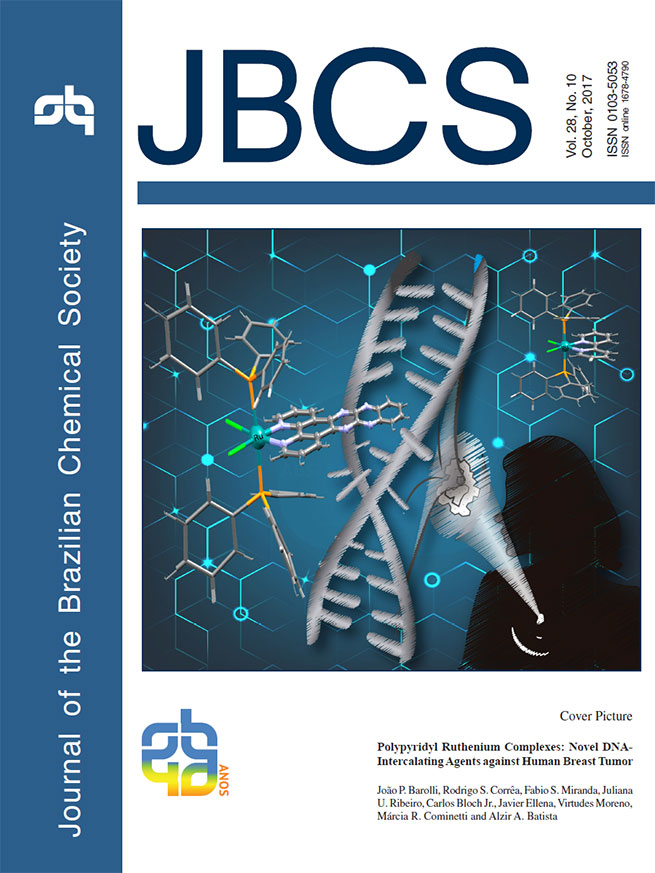vol. 28, No. 10, 2017, p. 1843-2044
Metal complexes remain an important resource for the generation of chemical diversity in the search for novel anticancer agents. The ruthenium possesses chemical properties that indicate it may be a strong candidate to form a basis for rational anticancer drugs. In the present study novel DNA-intercalating agents with promising anticancer activities, based on ruthenium(II) with the planar ligand dipyrido[3,2-a:2',3'-c]quinoxaline[2,3-b]quinoxaline) were evaluated for their cytotoxicity against human breast tumor cancer cells. Details are presented in the Article Polypyridyl Ruthenium Complexes: Novel DNA-Intercalating Agents against Human Breast Tumor by Joao P. Barolli, Rodrigo S. Corrêa, Fabio S. Miranda, Juliana U. Ribeiro, Carlos Bloch Jr., Javier Ellena, Virtudes Moreno, Márcia R. Cominetti and Alzir A. Batista on page 1879.
Polypyridyl Ruthenium Complexes: Novel DNA-Intercalating Agents against Human Breast Tumor
Joao P. Barolli; Rodrigo S. Corrêa; Fabio S. Miranda; Juliana U. Ribeiro; Carlos Bloch Jr.; Javier Ellena; Virtudes Moreno; Márcia R. Cominetti; Alzir A. Batista
How to cite this article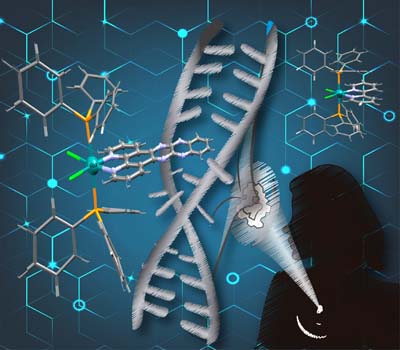
Metal complexes remain an important resource for the generation of chemical diversity in the search for novel anticancer agents. The ruthenium possesses chemical properties that indicate it may be a strong candidate to form a basis for rational anticancer drugs. In the present study novel DNA-intercalating agents with promising anticancer activities, based on ruthenium(II) with the planar ligand dipyrido[3,2-a:2',3'-c]quinoxaline[2,3-b]quinoxaline) were evaluated for their cytotoxicity against human breast tumor cancer cells. Details are presented in the Article Polypyridyl Ruthenium Complexes: Novel DNA-Intercalating Agents against Human Breast Tumor by Joao P. Barolli, Rodrigo S. Corrêa, Fabio S. Miranda, Juliana U. Ribeiro, Carlos Bloch Jr., Javier Ellena, Virtudes Moreno, Márcia R. Cominetti and Alzir A. Batista on page 1879.
https://dx.doi.org/10.21577/0103-5053.20170019
Articles J. Braz. Chem. Soc. 2017, 28(10), 1843-1849
Femtoliter Scale Detection of an Antithyroid Drug Using Gold Nanoparticles in a Microfluidic Chip
Atefeh Abbasi-Ahd; Nader Shokoufi; Sara Adeleh; Kazem Kargosha
How to cite this article
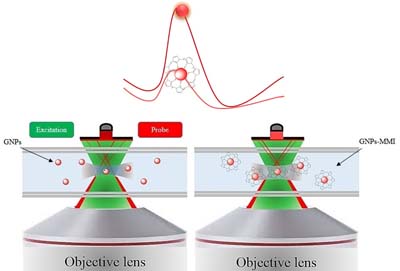
Photo thermal lens effect of gold nanoparticles (GNPs) capped with methimazole.
https://dx.doi.org/10.21577/0103-5053.20170011
J. Braz. Chem. Soc. 2017, 28(10), 1850-1856
Synthesis by Click Reactions and Antiplasmodial Activity of Lupeol 1,2,3-Triazole Derivatives
Tatiane F. Borgati; Guilherme R. Pereira; Geraldo C. Brandao; Juliana O. Santos; Dayane Aparecida M. Fernandes; Renata C. de Paula; Maria Fernanda A. do Nascimento; Luciana F. Soares; Júlio César D. Lopes; José D. de Souza Filho; Alaíde B. de Oliveira
How to cite this article
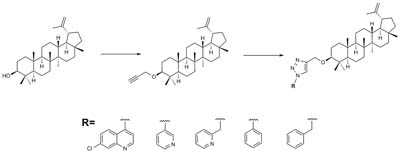
Five new lupeol 1,2,3-triazole derivatives were synthesized from lupeol which was isolated from Parahancornia fasciculata and were assayed for antiplasmodial and cytotoxic activity.
https://dx.doi.org/10.21577/0103-5053.20170013
J. Braz. Chem. Soc. 2017, 28(10), 1857-1865
Grape and Apple Pomaces from Southern Brazil: Valorization of By-Products through Investigation of Their Antioxidant Potential
Mariéli Karling; Thariane C. Bicas; Vanderlei Aparecido de Lima; Tatiane Luiza C. Oldoni
How to cite this article
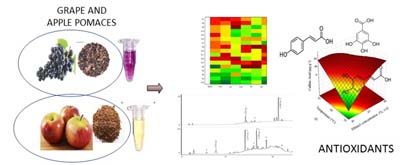
Optimizing the extraction of phenolic antioxidants from grape and apple pomaces from Brazil using response surface methodology.
https://dx.doi.org/10.21577/0103-5053.20170014
J. Braz. Chem. Soc. 2017, 28(10), 1866-1873
Magnetic Solid-Phase Extraction in Combination with Ultra High-Performance Liquid Chromatography-Tandem Mass Spectrometry Analysis: Quantification of Risperidone and 9-Hydroxyrisperidone in Biological Samples
Qinhong Yin; Yanqin Zhu; Yaling Yang
How to cite this article
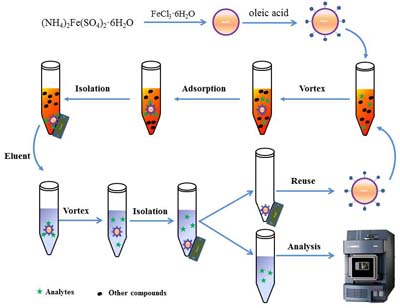
Magnetic solid phase extraction procedure used for the determination of targeted compounds in biological samples.
https://dx.doi.org/10.21577/0103-5053.20170016
J. Braz. Chem. Soc. 2017, 28(10), 1874-1878
Multi-gram Preparation of 7-Nitroquinoxalin-2-amine
Daniel N. do Amaral; Fernando R. de Sá Alves; Eliezer J. Barreiro; Stefan A. Laufer; Lídia M. Lima
How to cite this article
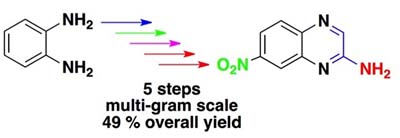
A methodology to obtain 7-nitroquinoxalin-2-amine using o-phenylenediamine as starting material in a five-step procedure in good yields and high purity.
This paper is part of the PubliSBQ Special Issue in honor of the late Prof Angelo da Cunha Pinto.
https://dx.doi.org/10.21577/0103-5053.20170018
J. Braz. Chem. Soc. 2017, 28(10), 1879-1889
Polypyridyl Ruthenium Complexes: Novel DNA-Intercalating Agents against Human Breast Tumor
Joao P. Barolli; Rodrigo S. Corrêa; Fabio S. Miranda; Juliana U. Ribeiro; Carlos Bloch Jr.; Javier Ellena; Virtudes Moreno; Márcia R. Cominetti; Alzir A. Batista
How to cite this article
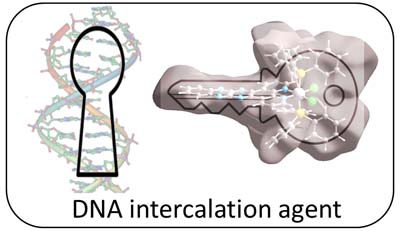
Ruthenium(II) complexes with the extended planar ligand [dipyrido[3,2-a:2′,3′-c]quinoxaline[2,3-b]quinoxaline)] have been synthesized and shown to be active against breast tumor cells (MDA-MB 231 and MCF-7).
https://dx.doi.org/10.21577/0103-5053.20170019
J. Braz. Chem. Soc. 2017, 28(10), 1890-1895
Commercial and Noncommercial Peroxidases Activity under Ultrasound and Microwave Treatment: a Pretreatment to Improve Wastewater Treatment
Simone M. Golunski; Thamarys Scapini; Tatiani Andressa Modkovski; Camila T. Marques; Aline F. Camargo; Karina Paula Preczeski; Camila Dalla Rosa; Daiane P. Baldissarelli; Jéssica Mulinari; Bruno Venturin; Gean D. L. P. Vargas; Jaqueline G. Buffon; Altemir José Mossi; Helen Treichel
How to cite this article
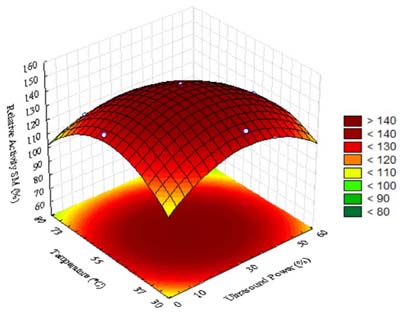
Using a power of 30% and a temperature of 55 °C an increase in relative activity of 147.9% in the enzyme from soybean meal was obtained.
https://dx.doi.org/10.21577/0103-5053.20170023
J. Braz. Chem. Soc. 2017, 28(10), 1896-1904
On the Fluorescent, Steric and Electronic Factors Affecting the Detection of Metallic Ions Using an Imidazolyl-Phenolic Derived Fluorescent Probe
Ronaldo B. Orfao Jr.; Fabrício de Carvalho; Paula Homem-de-Mello; Fernando H. Bartoloni
How to cite this article
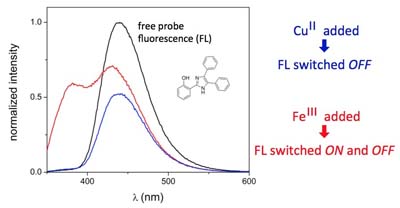
Addition of CuII or FeIII switches OFF the probe emission, but FeIII also induces the formation of a fluorescent coordinated compound (switch ON).
https://dx.doi.org/10.21577/0103-5053.20170024
J. Braz. Chem. Soc. 2017, 28(10), 1905-1910
Volatile Compounds from the Bark Bugs Phloea subquadrata and Phloeophana longirostris (Heteroptera: Phloeidae)
Francine S. A. da Fonseca; Adriana T. Salomao; Joao Vasconcellos-Neto; Thiago I. B. Lopes; Anita J. Marsaioli
How to cite this article
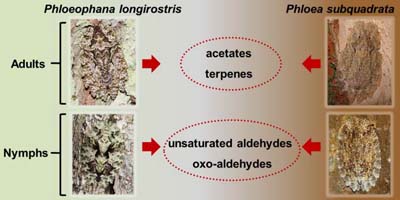
The volatile compounds differed both within and between Phloeidae species. Some compounds were sex specific, and others were characteristic of different developmental stages.
This article is part of the Special Issue BIOprospecTA-BIOTA.
https://dx.doi.org/10.21577/0103-5053.20170028
J. Braz. Chem. Soc. 2017, 28(10), 1911-1916
Isolation and Structural Characterization of Two New Furanoditerpenes from Pterodon emarginatus (Fabaceae)
Leandra A. R. Oliveira; Gerlon A. R. Oliveira; Geralda F. Lemes; Wanderson Romao; Boniek G. Vaz; Sérgio Albuquerque; Cristiana Gonçalez; Luciano M. Liao; Maria Teresa F. Bara
How to cite this article

Two new furanoditerpenes were obtained from Pterodon emarginatus. Methyl 6α-acetoxy-7β-hydroxyvouacapan-17β-oate (previously identified) showed leishmanicidal activity.
https://dx.doi.org/10.21577/0103-5053.20170029
J. Braz. Chem. Soc. 2017, 28(10), 1917-1925
Nuclear Magnetic Resonance (1.40 T) and Mid Infrared (FTIR-ATR) Associated with Chemometrics as Analytical Methods for the Analysis of Methyl Ester Yield Obtained by Esterification Reaction
Sara R. M. Kollar; Etelvino H. Novotny; Claudia J. do Nascimento; Paulo A. Z. Suarez
How to cite this article
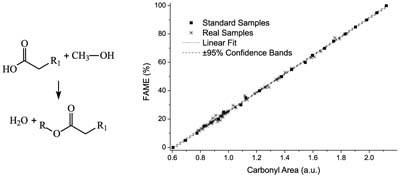
1H NMR (60 and 300 MHz) and FTIR-ATR associated with chemometrics were used to quantify esterification of fatty acids with methanol.
This paper is part of the PubliSBQ Special Issue in honor of the late Prof Angelo da Cunha Pinto.
https://dx.doi.org/10.21577/0103-5053.20170031
J. Braz. Chem. Soc. 2017, 28(10), 1926-1936
Synthesis of New Xanthenes Based on Lawsone and Coumarin via a Tandem Three‑Component Reaction
Mariana F. C. Cardoso; Luana S. M. Forezi; Victor G. S. Cavalcante; Cecília S. R. Juliani; Jackson Antônio L. C. Resende; David R. da Rocha; Fernando C. da Silva; Vitor F. Ferreira
How to cite this article

The synthesis of several xanthenes based on the 1,3-dicarbonyl scaffolds lawsone and coumarin was developed using tandem three-component reactions involving the reagents ortho-hydroxybenzaldehyde, as bifunctional reagent, and an appropriate thiol. These reactions generated two series of para- and ortho-naphthoxanthenes that are structurally related to α- and β-pyranaphthoquinones and one series of coumarin-xanthene derivatives.
This paper is part of the PubliSBQ Special Issue in honor of the late Prof Angelo da Cunha Pinto.
https://dx.doi.org/10.21577/0103-5053.20170032
J. Braz. Chem. Soc. 2017, 28(10), 1937-1946
Effects of Iron Enrichment of Adzuki Bean (Vigna angularis) Sprouts on Elemental Translocation, Concentrations of Proteins, Distribution of Fe-Metalloproteins, and Fe Bioaccessibility
Aline P. de Oliveira; Juliana Naozuka
How to cite this article
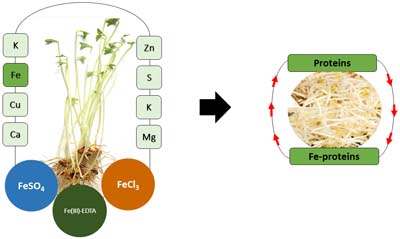
Enrichment effects with different iron species on translocation of this element, chemical composition (essential elements, proteins and Fe-proteins) and Fe bioaccessibility.
https://dx.doi.org/10.21577/0103-5053.20170034
J. Braz. Chem. Soc. 2017, 28(10), 1947-1952
A Novel Nanofibrous Film Chemosensor for Highly Selective and Sensitive Optical Signaling of Zn2+
Chen Zhou; Heng Liu
How to cite this article

Recognition mechanism of the nanofibrous film chemosensor for Zn2+.
https://dx.doi.org/10.21577/0103-5053.20170036
J. Braz. Chem. Soc. 2017, 28(10), 1953-1959
New Design of Mini PTFE Vessels for Sample Preparation in Micro Scale: Determination of Cd, K, Mg and Na in Biological Sample
Camila M. Oliz; Alexander O. Souza; Camila C. Pereira; Richard M. Oliveira; Aline L. Medina; Mariana A. Vieira; Anderson S. Ribeiro; Adriane M. Nunes
How to cite this article
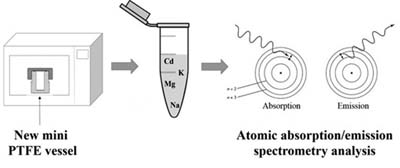
The new mini PTFE vessel was evaluated as a potential system for the preparation of biological samples and subsequent determination of metals.
https://dx.doi.org/10.21577/0103-5053.20170037
J. Braz. Chem. Soc. 2017, 28(10), 1960-1965
Determination of Rare Earth Elements in Some Flower Herb Teas and their Infusions
Zhanglin Ni; Chuanyi Ren; Junyong Cheng; Fubin Tang
How to cite this article

The sixteen rare earth elements content in twelve types of popular flower herb teas and their infusions consumed in China was evaluated by ICP-MS.
https://dx.doi.org/10.21577/0103-5053.20170039
J. Braz. Chem. Soc. 2017, 28(10), 1966-1974
Application of Full Factorial Design to Evaluate the Effect of Different Variables on the Stability of Biodiesel:Diesel Blends under Storage Conditions
Michelle J. C. Rezende; Daniella L. Vale; Paula F. Aguiar; Carlos A. S. Riehl; Debora A. Azevedo
How to cite this article
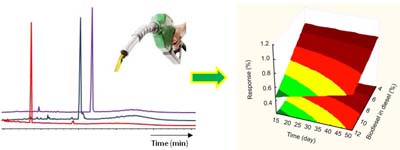
The stability of biodiesel:diesel blends were studied in actual Brazilian storage conditions. The degradation was quantified by target compounds in the oxidation process and a full factorial design evaluated the effect of variables.
This paper is part of the PubliSBQ Special Issue in honor of the late Prof Angelo da Cunha Pinto.
https://dx.doi.org/10.21577/0103-5053.20170041
J. Braz. Chem. Soc. 2017, 28(10), 1975-1987
Using Magnetized (Fe3O4 / Biochar Nanocomposites) and Activated Biochar as Adsorbents to Remove Two Neuro-Active Pesticides from Waters
Tassya T. S. Matos; Juliana Schultz; Muhammad Y. Khan; Everton F. Zanoelo; Antônio S. Mangrich; Bruno R. Araújo; Sandro Navickiene; Luciane P. C. Romao
How to cite this article
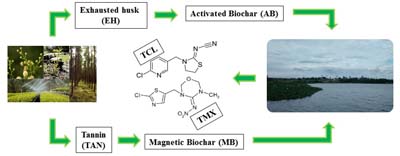
Biochars prepared from exhausted husk (EH) and tannin (TAN) derived from black wattle were used to remove thiacloprid (TCL) and thiamethoxam (TMX) agrotoxics from spiked sample of the Marcela Dam, a natural reservoir in Itabaiana Municipality, Sergipe State, Brazil.
https://dx.doi.org/10.21577/0103-5053.20170042
J. Braz. Chem. Soc. 2017, 28(10), 1988-1994
Boron Isotopic Ratio in Brazilian Red Wines: a Potential Tool for Origin and Quality Studies?
Cibele M. S. de Almeida; Ana Cristina Almeida; Tatiana D. Saint'Pierre; José Marcus Godoy
How to cite this article
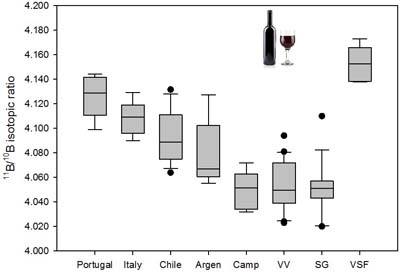
Boron isotopic composition was applied as a tool to differentiate among Brazilian red wine origin. The results have demonstrated that is possible to discriminate between wines produced on the Southern region from those produced on Sao Francisco Valley and also between the Brazilian red wines from Chilean, Italian and Portuguese wines.
https://dx.doi.org/10.21577/0103-5053.20170043
J. Braz. Chem. Soc. 2017, 28(10), 1995-2003
Synthesis of TiO2/SiO2-B2O3 Ternary Nanocomposites: Influence of Interfacial Properties on their Photocatalytic Activities with High Resolution Mass Spectrometry Monitoring
Susana F. Resende; Rafael L. Gouveia; Bernardo S. Oliveira; Wander L. Vasconcelos; Rodinei Augusti
How to cite this article
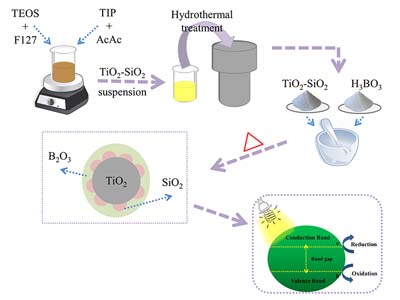
Summary of the process used to synthesize the TiO2/SiO2-B2O3 ternary nanocomposites.
https://dx.doi.org/10.21577/0103-5053.20170044
J. Braz. Chem. Soc. 2017, 28(10), 2004-2012
Composite Superabsorbent Hydrogel of Acrylic Copolymer and Eggshell: Effect of Biofiller Addition
Marcos Vinícius A. Queirós; Maslândia N. Bezerra; Judith P. A. Feitosa
How to cite this article
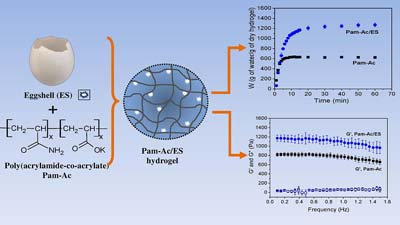
The addition of eggshell to an acrylic copolymer improves the gel strength and the water absorption and also provides a more useful destination for the residue.
https://dx.doi.org/10.21577/0103-5053.20170046
J. Braz. Chem. Soc. 2017, 28(10), 2013-2020
An Automated Multicommuted Flow Analysis Procedure for Photometric Determination of Reducing Sugars in Wine Employing a Directly Heated Flow‑Batch Device
Marcos A. S. Brasil; Boaventura F. Reis
How to cite this article
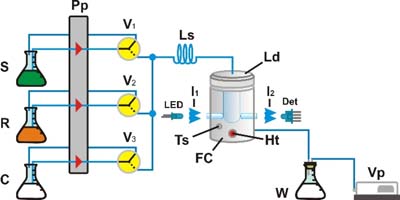
Diagram of the setup for reducing sugar determination in wines.
https://dx.doi.org/10.21577/0103-5053.20170047
Short Report J. Braz. Chem. Soc. 2017, 28(10), 2021-2027
"Sweet Chemistry": a Green Way for Obtaining Selenium Nanoparticles Active against Cancer Cells
Adriana P. Vieira; Erika M. Stein; Daniel X. Andreguetti; Gerardo Cebrián‑Torrejón; Antonio Doménech-Carbó; Pio Colepicolo; Ana Maria D. C. Ferreira
How to cite this article
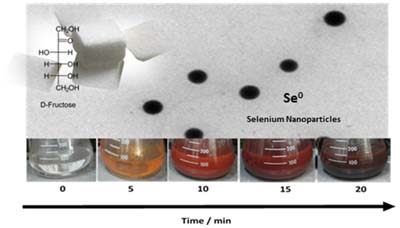
A clean synthesis was developed to prepare selenium nanoparticles using fructose as the reducing agent. The obtained nanoparticles presented high toxicity toward cancer cells, and on the contrary are not toxic against human P4 fibroblasts.
https://dx.doi.org/10.21577/0103-5053.20170025
J. Braz. Chem. Soc. 2017, 28(10), 2028-2037
Synthesis, Inhibition of Mycobacterium tuberculosis Enoyl-acyl Carrier Protein Reductase and Antimycobacterial Activity of Novel Pentacyanoferrate(II)‑isonicotinoylhydrazones
Thais P. Gazzi; Mariane Rotta; Anne D. Villela; Valnês Rodrigues-Junior; Leonardo K. B. Martinelli; Francisco Adilson M. Sales; Eduardo Henrique Silva de Sousa; Maria Martha Campos; Luiz Augusto Basso; Diógenes S. Santos; Pablo Machado
How to cite this article
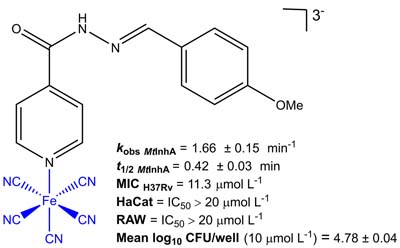
The pentacyanoferrate(II)-isonicotinoylhydrazones inhibited the reaction catalyzed by Mycobacterium tuberculosis 2-trans-enoyl-ACP(CoA) reductase (MtInhA), showed antitubercular activity against M. tuberculosis H37Rv strain with no apparent toxicity to mammalian cells and presented intracellular activity in a macrophage model of infection.
https://dx.doi.org/10.21577/0103-5053.20170033
J. Braz. Chem. Soc. 2017, 28(10), 2038-2044
Synthesis of Diiodo-Functionalized Benzo[b]furans via Electrophilic Iodocyclization
Carlise Frota; Allan F. C. Rossini; Gleison A. Casagrande; Lucas Pizzuti; Cristiano Raminelli
How to cite this article
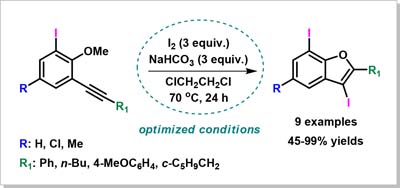
Diiodo-functionalized benzo[b]furans were achieved through a simple electrophilic iodocyclization reaction involving alkynylated
2-iodoanisoles and molecular iodine in the presence of sodium bicarbonate.
https://dx.doi.org/10.21577/0103-5053.20170035
Online version ISSN 1678-4790 Printed version ISSN 0103-5053
Journal of the Brazilian Chemical Society
JBCS Editorial and Publishing Office
University of Campinas - UNICAMP
13083-970 Campinas-SP, Brazil
Free access










